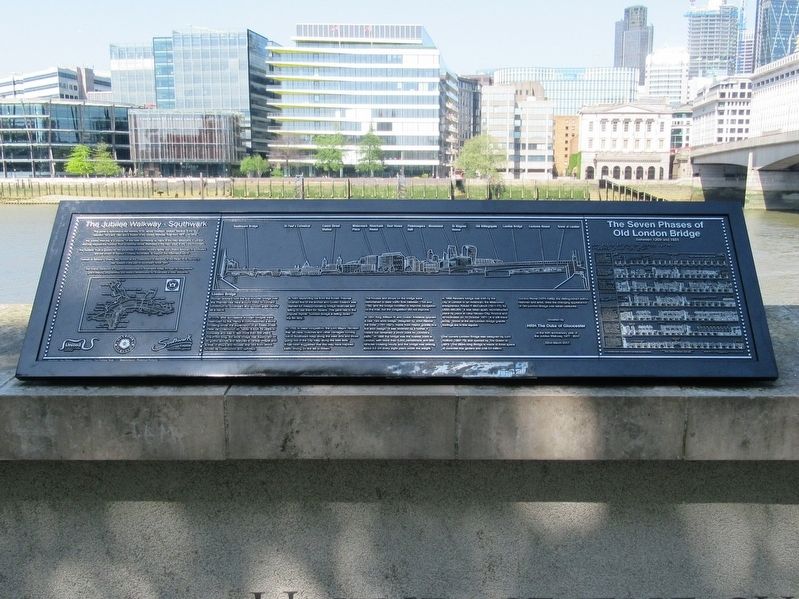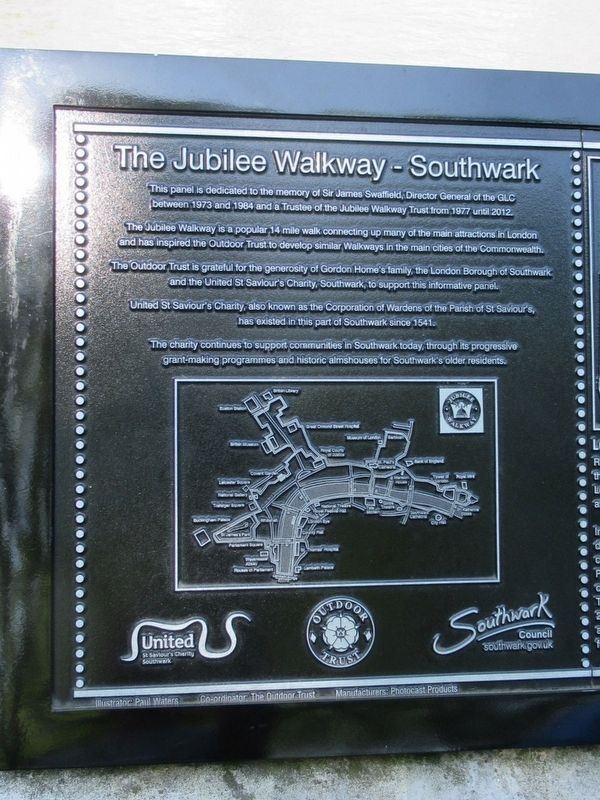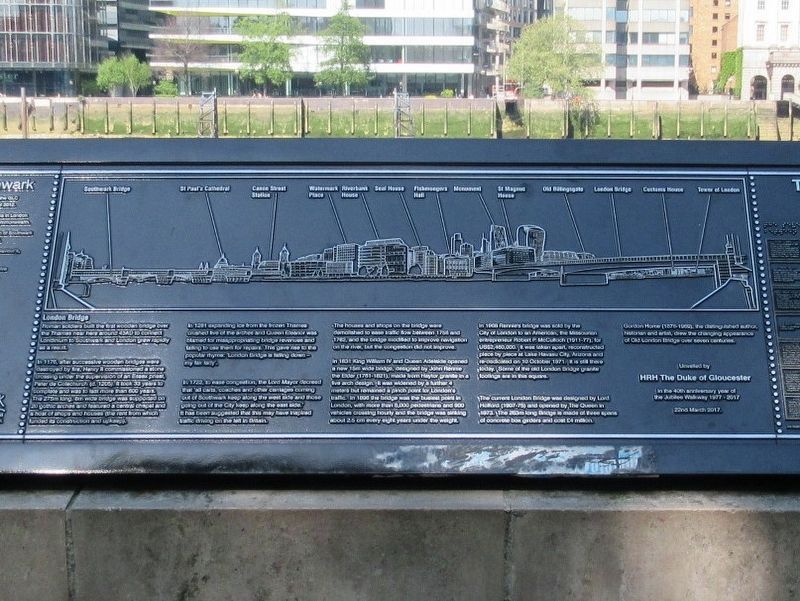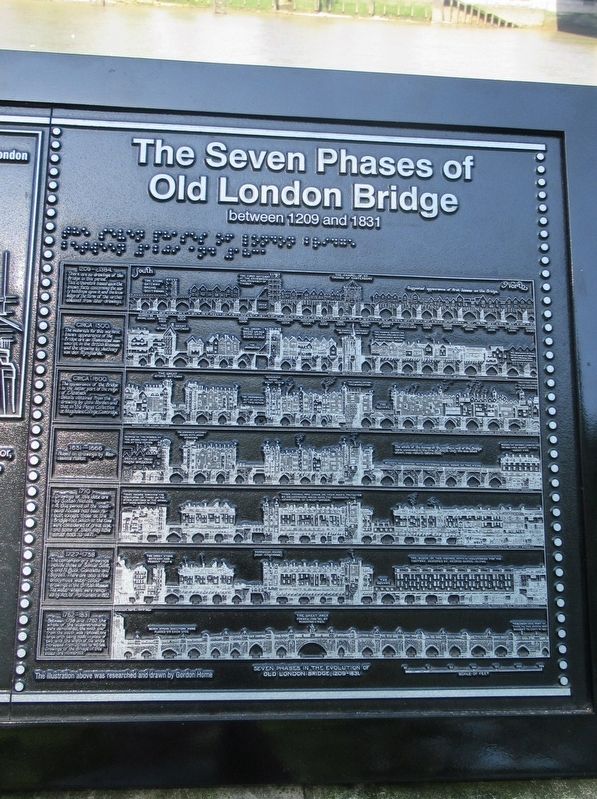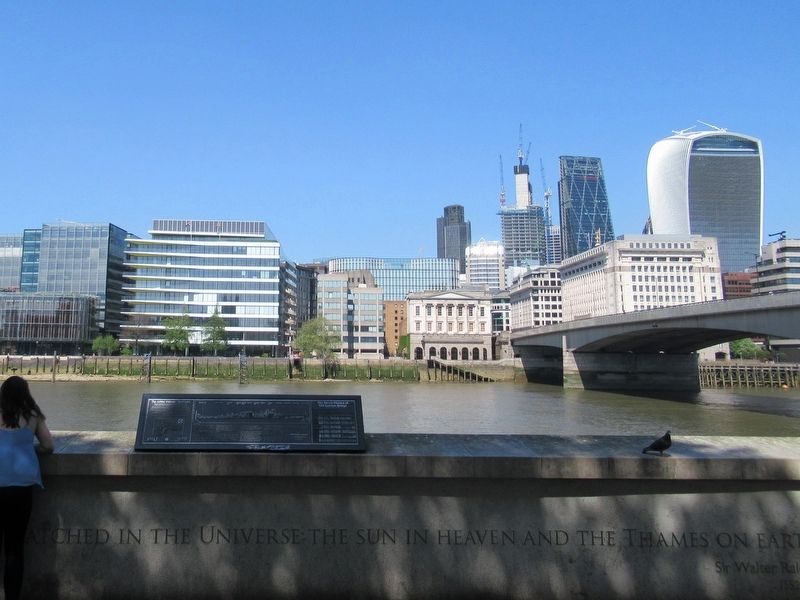Southwark in Greater London, England, United Kingdom — Northwestern Europe (the British Isles)
The Jubilee Walkway – Southwark
The Jubilee Walkway – Southwark
This panel is dedicated to the memory of Sir James Swaffield, Director General of the GLC between 1973 and 1984 and a Trustee of the Jubilee Walkway Trust from 1977 until 2012.
The Jubilee Walkway is a popular 14 mile walk connecting up many of the main attractions in London and has inspired the Outdoor Trust to develop somilar Walkways in the main cities of the Commonwealth.
The Outdoor Trust is grateful for the generosity of Gordon Home’s family, the London Borough of Southwark and the United St Saviour’s Charity, also known as the Corporation of Wardens of the Parish of St Saviour’s Charity, Southwark, to support this informative panel.
United St Saviour’s Charity, also known as the Corporation of Wardens of the Parish of St Saviour’s has existed in this part of Southwark since 1541.
The charity continues to support communities in Southwark today, through its progressive grant-making programmes and historic almshouses for Southwark’s older residents.
London Bridge
Roman soldiers built the first wooden bridge over the Thames near here around 43AD to connect Londinium to Southwark and London grew rapidly as a result.
In 1176, after successive wooden bridges were destroyed by fire, Henry II commissioned a stone crossing under the supervision of an Essex priest, Peter de Colechurch (d. 1205). It took 33 years to complete and was to last more than 600 years. The 275m long, 8m wide bridge was supported on 20 gothic arches and featured a central chapel and a host of shops and houses (the rent from which funded its construction and upkeep).
In 1281 expanding ice from the frozen Thames crushed five of the arches and Queen Eleanor was blamed for misappropriating bridge revenues and failing to use them for repairs. This gave rise to the popular rhyme: ‘London Bridge is falling down — my fair lady’.
In 1722, to ease congestion, the Lord Mayor decreed that ‘all carts, coaches and other carriages coming out of Southwark keep along the west side and those going out of the city keep along the east side.’ It has been suggested that this may have inspired traffic driving on the left in Britain.
The houses and shops on the bridge were demolished to ease traffic flow between 1758 and 1762, and the bridge modified to improve navihation on the river, but the congestion did not improve.
In 1831 King William IV and Queen Adelaide opened a new 15m wide bridge, designed by John Rennie the Elder (1761 – 1821), made from Haytor granite in a five arch design. It was widened by a further 4 meters but remained a pinch point for London’s traffic. In 1896 the bridge was the busiest point in London, with more than 8,000 pedestrians and 900 vehicles crossing hourly and the bridge was sinking about 2.5 cm every eight years under the weight.
In 1968 Rennie’s bridge was sold by the City of London to an American, the Missourian entrepeneur Robert P. McCulloch (1911-77), for US$2,460,000. It was taken apart, reconstructed piece by piece at Lake Havasu City, Arizona and re-dedicated on 10 October 1971. It is still there today. some of the old London Bridge granite footings are in this square.
The current London Bridge was designed by Lord Holford (1907-75) and opened by The Queen in 1973. The 283m long Bridge is made of three spans of concrete box girders and cost £4 million.
Gordon Home (1878-1969), the distinguished author, historian and artist, drew the changing appearance of Old London Bridge over seven centuries.
HRH The Duke of Gloucester
In the 40th anniversary year of
The Jubilee Walkway 1977-2017
22nd March 2017
Circa 1500. The materials for this earliest known appearance of the Bridge are an illuminated manuscript in the British Museum and the drawing by Anthony van den Wyngaerde.
Circa 1600. The appearance of the Bridge in the latter part of the reign of Elizabeth. Details obtained from the drawing by John Norden and that in the Pepys Collection at Magdalene Colleg, Cambridge.
1651 — 1666 Based on drawings by Wenceslaus Hollar.
1710 Drawings at this date are by Sutton Nicholls. At this period all the mediaeval houses had been rebuilt except those at the Bridge-foot, which at the time were considered of great age, and some of them may have dated back to 1471.
1727 — 1758 The contemporary drawings include those of Samuel Scott, S. and N. Buck, Canaletto and Bpoydell. There are also a few anonymous water-colour drawings in the British Museum. The water-wheels were removed by Act of Parliament in 1822.
1762 — 1831 Between 1758 and 1762 the whole of the superstructures were demolished, the ninth pier from the south was removed, one large arch being made in place of two and the width of the whole increased from 20 feet to 46 feet. Drawings of the Bridge in this state are numerous.
Topics. This historical marker is listed in these topic lists: Bridges & Viaducts • Parks & Recreational Areas.
Location. 51° 30.43′ N, 0° 5.423′ W. Marker is in Southwark, England, in Greater London. Marker can be reached from the intersection of Stoney Street and Clink Street, on the right when traveling north. Located at Pickfords Wharf on the deck of the Old Thameside Inn, overlooking the River Thames. Touch for map. Marker is in this post office area: Southwark, England SE1 9DG, United Kingdom. Touch for directions.
Other nearby markers. At least 8 other markers are within walking distance of this marker. Old Thameside Inn (here, next to this marker); a different marker also named Old Thameside Inn (a few steps from this marker); The Legend of Mary Overie (a few steps from this marker); Sir Francis Drake (within shouting distance of this marker); Queen Elizabeth I (within shouting distance of this marker); Winchester Palace (within shouting distance of this marker); St. Saviour’s Southwark Private Property (within shouting distance of this marker); St. Mary Overie’s Dock (within shouting distance of this marker). Touch for a list and map of all markers in Southwark.
Also see . . . London Bridge on Wikipedia. (Submitted on June 21, 2018, by Michael Herrick of Southbury, Connecticut.)
Credits. This page was last revised on January 27, 2022. It was originally submitted on June 21, 2018, by Michael Herrick of Southbury, Connecticut. This page has been viewed 275 times since then and 18 times this year. Photos: 1, 2, 3, 4, 5. submitted on June 21, 2018, by Michael Herrick of Southbury, Connecticut.
